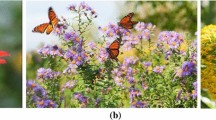Abstract
This paper presents a novel optimization framework for classic windows using a bio-inspired methodology, the firefly algorithm. Classic windows are widely used as sidelobe control for signals undergoing discrete Fourier transform processing. In general, the lower sidelobes of nonrectangular windows have been achieved at the cost of broadening of the mainlobe width (MW). Here, the novel optimized windows allow a better peak sidelobe ratio without MW broadening. The simulation results show the effectiveness of the proposal for sidelobe reduction for the purpose of radar range imaging while preserving resolution.




Similar content being viewed by others
References
J.W. Adams, A new optimal window. IEEE Trans. Signal Process. 39(8), 1753–1769 (1991)
S.T. Ahsan, Optimal window design. IEEE Potentials 21(5), 40–44 (2002)
S. Chetty, A.O. Adewumi, Comparison study of swarm intelligence techniques for the annual crop planning problem. IEEE Trans. Evol. Comput. 18(2), 258–286 (2014)
S.M. Farahani, A.A. Abshouri, B. Nasiri, M.R. Meybodi, A Gaussian firefly algorithm. Int. J. Mach. Learn. Comput. 1(5), 448–453 (2011)
S. Kay, D. Smith, An optimal sidelobeless window. IEEE Trans. Signal Process. 47(9), 1753–1769 (1999)
M.K. Marichelvam, T. Prabaharan, X.S. Yang, A discrete firefly algorithm for the multi-objective hybrid flowshop scheduling problems. IEEE Trans. Evol. Comput. 18(2), 301–305 (2014)
A.V. Oppenheim, R.W. Schafer, J.R. Buck, Discrete-Time Signal Processing, 2nd edn. (Prentice-Hall, Englewood Cliffs, 1999)
M.A. Richards, Fundamentals of Radar Signal Processing (McGraw-Hill, New York, 2005)
Z.H. Xu, Y.K. Deng, Y. Wang, Exploring lower peak sidelobe windows with the same mainlobe as rectangular window via nature-inspired methodology. Int. J. Electron. Commun. (AEÜ) 69(4), 776–780 (2015)
X.S. Yang, Nature-Inspired Metaheuristic Algorithms (Luniver Press, Frome, 2008)
X.S. Yang, X.S. He, Firefly algorithm: recent advances and applications. Int. J. Swarm Intell. 1(1), 36–50 (2013)
C.M. Zierhofer, Data window with tunable side lobe ripple decay. IEEE Signal Process. Lett. 14(11), 824–826 (2007)
Acknowledgments
We would first like to express our sincere appreciation to the two anonymous reviewers and the Associate Editor for their helpful suggestions and valuable comments. Also, we owe a very special thanks to the Editor-In-Chief, Professor M.N.S. Swamy for his invaluable help and suggestions.
Author information
Authors and Affiliations
Corresponding author
Rights and permissions
About this article
Cite this article
Xu, Zh., Deng, Yk. & Wang, Y. A Novel Optimization Framework for Classic Windows Using Bio-Inspired Methodology. Circuits Syst Signal Process 35, 693–703 (2016). https://doi.org/10.1007/s00034-015-0079-4
Received:
Revised:
Accepted:
Published:
Issue Date:
DOI: https://doi.org/10.1007/s00034-015-0079-4



